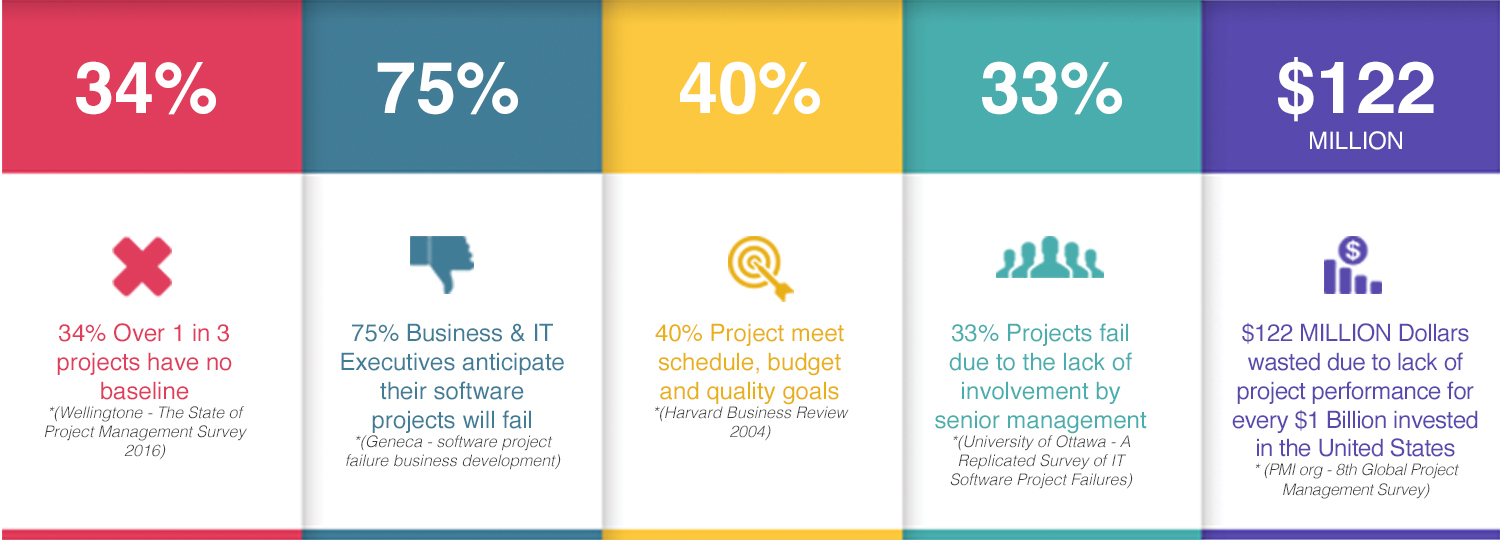IT projects often wind up taking additional time than planned and escalate costs much higher than anticipated. These are the two common complaints of many C-suite executives. Although a good deal of tools including cloud-based software collaboration is available to manage complex IT projects, scores of IT projects fail to either make it to the deployment stage or lag behind a projected timeline.
Starting from poor management to scarcity of resources and from bad communication to wrong budgeting, there are ample of reasons behind a failed IT project execution. It does not matter whether you ask why IT projects fail or Why IT projects succeed; both the questions offer us an opportunity to examine the various reasons responsible for making or breaking the project.

Five Reasons Making or Breaking an IT Project
1: Insufficient and Ineffective Communication
In an IT project, you cannot expect everyone involved in it must possess excellent technical knowledge. Along with technical people, you might want to deal with non-technical executives. Efforts should be taken to smoothly traverse the communication barriers or to avoid the communication breakdown.
You need a good communicator, a visionary storyteller who can regularly, clearly, and concisely communicate with non-technical executives to update them about the project status. Apart from that, he/she should be in frequent communication with the development team, sponsors, business users and hardware vendors to convey objective status reports, discuss risks and resolve the pressing issues, thereby preventing possible project failures.
Solution: A proper communication plan needs to be formulated in the initial stage of project planning. The plan must describe the schedule of regular meetings (Scrum/Agile), preferable mode or tools of communication, and the participants of each meeting.
2: Lame Project Planning
Poor or lame project planning is a volatile term described in a multitude of ways. If the specification of a project are not sufficiently defined, if the scope of the project is not effectively marginalised or if the complexity of the project is not precisely estimated; then it surely is an example of lame project planning. Failure to break the large scale master project plan into smaller manageable milestones, unclear goals and responsibilities amongst resources, no proper risk mitigation or requirement handling policy is a classic example of poor project planning.
According to Murphy’s Law “If anything has to go wrong, it will”. Therefore, do not move ahead unless you understood the work well, as agreed by the project sponsors and key stakeholders. Before planning a project, you need to have a common perception of project deliverable, expected end date, anticipated budget, work schedule, resources and benefits offered by the project. Plan the project upfront formally and explicitly, by directly equating efforts with the elapsed task duration leaving abundant buffer or room for the non-productive time.
Solution: Take your time and create an elaborate, effective and productive project plan. You can use our illustrative project planning template offered with this blog or you can use different project planning tools to successfully plan a project. A perfect plan addresses all the issues like project estimate, management & allocation of resources, identifying & mitigating risks, Budget forecast and effective reporting as well as communication policies.
3: Poor Project Management

Although the majority of companies believe, ‘good project management is imperative for business performance and success of an organization’. Still, not all project managers prefer using project management tools or software. Nevertheless, managing multiple projects at a time and multitasking resources enhances complexity and schedule risks, further impacting all the projects involved.
A good project management starts by considering ‘Less is more and Focus is power’. Failure to resist the temptation of using newer technology without proper training introduces new challenges to complete the project in time. A bad project manager or PM without much knowledge and experience to handle the project independently is also one of the causes behind poor project management. Managing a project is also about managing resources and managing schedule, mismanaging any of them leads to project failure.
Solution: Allocate resources, personnel, and energy according to the scope and priority of the project. Having more project management professionals on staff does not hurt; in fact, it will be a plus point to manage the project effectively, especially when these skills seem to be abating. A successful project management starts by efficient resource allocation, effective planning, and aggressive working. Thus, at any given point, you clearly determine where your project stands versus where you planned to be at that point, how much work your team has actually completed versus what you had projected to complete.
4: Lack of Involvement by Senior Management
The support an IT project receive from its upper management plays a pivotal role in making or breaking an IT project. Not all the CEO’s and top-level management are highly aware of the benefits and purpose behind a specific IT project. Nevertheless, demanding unworkable solutions or laying inordinate restrictions might sabotage the IT project, which is often unintentional.
Involvement of C-suite executives is necessary and not limited to the project kickoff meeting. Plan project meetings targeting eternal involvement of C-suite executives for some specific status report meetings. Especially, request their compulsory presence to monitor project progress where you want to solicit go/no-go type of decisions.
Solution: When you need to set up a program for success, you must develop, articulate and stick to a coherent and unified strategy that ensures your organization is aligned around a common set of realistic and achievable goals. The senior level management must provide the necessary resources to get the job done and be actively engaged throughout the project life cycle. Above all, the C-suite executives should take an initiative to accept the accountability of project deliverable along with IT teams ensuring that project schedules and antecedence do not hinder success.
5: Nonexistent Quality Controls
Quality control is not much discussed or highlighted in the project plans, which frequently leads to different people having different expectations from the end-product and the standards, it must achieve. The high quality of a product is not just precision in the deliverable, but it also imparts the working culture of your organization. Assuming you know what users, want is a self-derogatory claim. Conversely, user testing allows you to prioritize the different set of needs and problems faced by users.
Give utmost importance to create a quality plan encompassing appropriate reviews, tests or checkpoints to verify the quality of the product. Prepare review documents and design papers by highlighting substantive issues. Remember the quality of the project is a shared responsibility and not only restricted to the Quality Assurance Group.
Solution: prefer a structured approach to QA and test planning, in order to complete a project successfully maintain the high quality of the deliverable by ensuring its benefits are in line with the client expectations. Do not treat testing as a last minute resort and never have overconfidence in the development team, thinking they will create a bug-free product. Align testing schedule and testing strategy without skipping anything from loading to acceptance testing. Configure the testing environment differently from the target development or development environment wherein project deliverable is used.
CONCLUSION:
Organizations putting their efforts in illustrative project planning and effective project management waste about 13 times less money, as they are able to complete their strategic initiatives more precisely. If you want to deliver value to your organizations and stay relevant and competitive in a global economy that is still uncertain; then plan, manage and execute your IT project effectively.
Focus your attention on closing the gaps between how C-suite executives, Top-level directors, and project managers perceive organizational investment in project planning, program, and management. Identify the project and program benefits are treat them as integral parts of the business case. Ensure business value is derived from them by tracking it from project initiation through transfer to the business and beyond. In short, having a greater awareness of how strategic objectives are achieved requires a benefit realization process.
Embrace project planning as a strategic competency to reduce risks, cut costs, and improve the success rate.
Get a Project Success Strategy in place of your Business & Constantly Improve the Performance of your IT Project.





